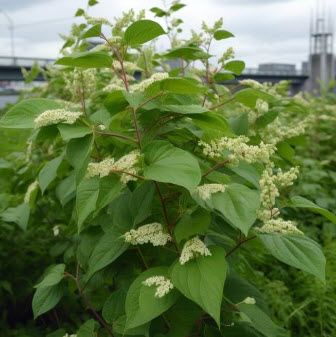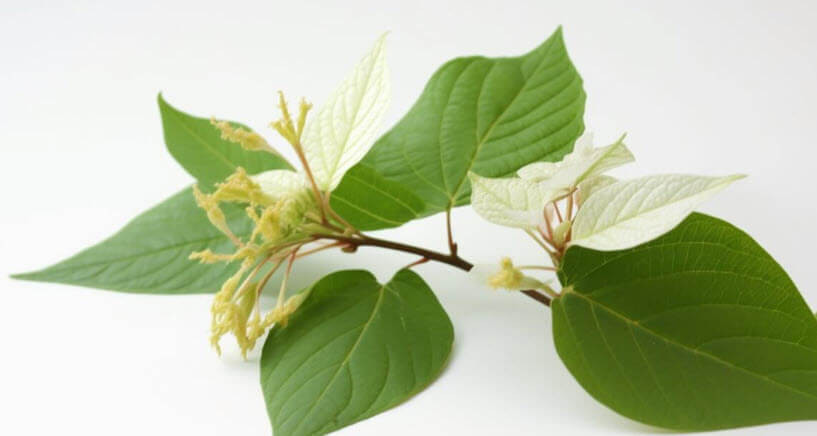Would you prefer to listen to a short podcast discussion about this article? Click on the audio below.
If there’s one plant that can strike fear into the hearts of homeowners, gardeners, and environmentalists alike, it’s the Japanese knotweed. This invasive species has been causing problems in countries all over the world, and it seems like everyone has a horror story about its destructive tendencies.
Table of Contents
But what is it, exactly? And why is it such a big deal? In this blog post, we’ll take a deep dive into the world of this invasive plant, exploring its history, biology, impact on the environment, and statistics on damage caused. We’ll also answer some frequently asked questions about this troublesome plant and share some success stories of control methods.
What is Japanese Knotweed?
Knotweed (Fallopia japonica) is a large, herbaceous perennial plant that is native to Japan, China, and Korea. It was first introduced to Europe and North America in the mid-19th century as an ornamental plant, prized for its attractive foliage and showy flowers. However, it quickly became apparent that it was not a well-behaved garden plant.
The Knotweed grows quickly and aggressively, spreading through rhizomes (underground stems) that can extend up to 7 meters from the parent plant. It can grow up to 3 meters tall and has distinctive, heart-shaped leaves. In late summer and early autumn, it produces small, creamy-white flowers that are arranged in dense, branching clusters.
Why is it Such a Problem?
The problem with it is that it is incredibly difficult to control once it gets established. The plant can grow through concrete, tarmac, and even brick walls, causing damage to buildings and infrastructure. In fact, according to a 2010 study by the Environment Agency in the UK, Japanese knotweed was found to cause over £165 million ($225 million) worth of damage to buildings and infrastructure each year.
It can also outcompete native plants, reducing biodiversity and altering ecosystems.
In addition to its physical impact, the invasive plant is also a legal liability. In many countries, including the UK and the US, it is classified as “controlled waste” under waste disposal regulations. This means that it cannot be disposed of in ordinary landfill sites and must be transported to licensed waste facilities at great expense.
How to Identify Japanese Knotweed?
Identifying Japanese knotweed is relatively easy once you know what to look for. The plant has distinctive features that set it apart from other similar-looking species.
- Heart-shaped leaves: The leaves are broad and heart-shaped, with a pointed tip. They are green in colour and can grow up to 14 cm long.
- Red stems: The stems are red or purple in colour and are hollow. They are also covered in small, raised nodes or “joints.”
- Dense clusters of flowers: In late summer and early autumn, the plant produces small, creamy-white flowers that are arranged in dense clusters.

How to Control Japanese Knotweed?
Controlling it can be a difficult and time-consuming process, but it is possible with the right approach. Here are some of the most effective methods:
- Chemical control: The most common method of control is to use herbicides. Glyphosate-based herbicides are the most effective, but they must be applied at the right time of year and in the correct concentration.
- Physical control: Physical methods of control include digging up the plant and removing as much of the root system as possible. This can be a labour-intensive process, and it may not be effective if the plant has spread too far.
- Biological control: Several biological control methods are being researched, including introducing natural predators and using fungal pathogens to attack the plant. However, these methods are still in the experimental stage and may not be effective in all situations.
Success Stories of Control Methods
Despite the challenges of controlling the knotweed, there are success stories of communities, businesses, and individuals who have managed to get a handle on this invasive species. Here are a few examples:
- In the UK, the Royal Botanic Gardens in Kew have successfully eradicated the plant from their property using a combination of chemical and physical control methods.
- In the US, the city of Boston has a Japanese Knotweed Management Plan that includes a mix of chemical and physical control methods, as well as ongoing monitoring and education efforts.
- In Canada, the city of Hamilton has implemented a program that uses goats to graze on Japanese knotweed in natural areas, reducing the plant’s spread and impact on the ecosystem.
These success stories demonstrate that it is possible to control Japanese knotweed with the right approach and ongoing management. By working together and staying vigilant, we can protect our homes, gardens, and natural environments from the destructive tendencies of this invasive species.
FAQs
Q: Is Japanese knotweed poisonous?
A: No, the plant is not poisonous. It is safe to touch and handle, although it is important to take precautions when removing it to avoid spreading it further.
Q: Can Japanese knotweed grow in shade?
A: Yes, it can grow in shade, although it prefers sunny or partially shaded locations.
Q: Can Japanese knotweed be composted?
A: No, it cannot be composted. Even small fragments of the plant can grow into new plants, so it is important to dispose of it properly.
Q: Can Japanese knotweed be eradicated completely?
A: While it may be difficult to eradicate Japanese knotweed completely, it is possible to control it and prevent it from spreading further. With the right approach and ongoing management, it is possible to keep Japanese knotweed under control and minimize its impact on the environment.
Final Thoughts
So, there you have it – everything you ever wanted to know about Japanese knotweed. While it may seem like a scary plant, it’s important to remember that it is possible to control and manage it. By taking action to prevent its spread and eliminate it where it has taken root, we can minimize the damage caused by this foreign invader and preserve the beauty and biodiversity of our natural world.
Here is an infographic on how to remove this plant by Knotweed Services

If you need any further information or assistance with this article, don’t hesitate to Contact Us
,




















